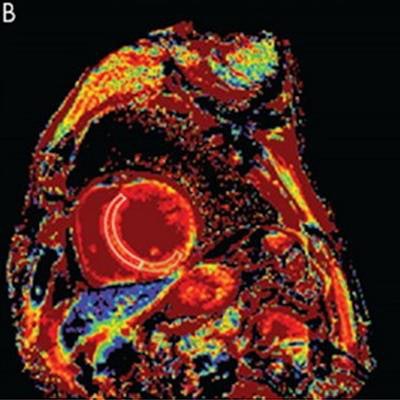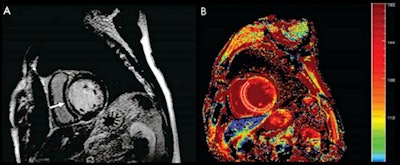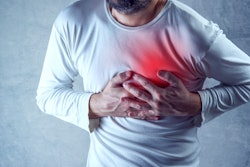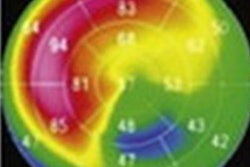
Cardiac MRI shows promise as an effective, noninvasive way to screen for heart disease, according to a study published April 1 in Radiology: Cardiothoracic Imaging.
Using the modality for this purpose could mitigate patients' cardiovascular disease risk, wrote a team led by Dr. Cynthia Philip of Walter Reed National Military Medical Center in Bethesda, MD.
"While [cardiac MRI] is not currently approved for screening, this noninvasive modality is safe and increasingly available," the group noted. "In the future there may be indication to use [it] to evaluate for preclinical disease to reduce cardiovascular risk."
Cardiovascular disease is the leading cause of death around the world, driven by such factors as obesity, lack of physical activity, diet, and high blood pressure. That's why earlier intervention "to prevent adverse clinical events could reduce the burden of myocardial infarction and stroke, premature death, and heart failure, which are all end-stage clinical manifestations of this cardiometabolic-based chronic disease," Philips and colleagues wrote.
In a literature review, the authors assessed current evidence and future potential for cardiac MRI as a screening test for people at higher risk of heart disease. They also evaluated the following existing tools for heart disease screening in patients at increased risk:
Radionuclide myocardial perfusion imaging. "Despite the identification of a significant prevalence of subclinical myocardial ischemia [in asymptomatic diabetic patients], adverse cardiac events were not significantly reduced by screening with nuclear imaging at five-year follow-up," the team wrote.
Cardiac CT angiography. Like nuclear imaging, screening CT angiography of diabetic patients identifies subclinical disease, namely atherosclerosis, but it "has not demonstrated an outcomes benefit," according to Philip and colleagues.
Carotid ultrasound and cardiac CT angiography. The researchers cited a 2016 study that included 98 diabetic patients who were screened for subclinical coronary artery disease with carotid ultrasound, coronary artery calcium scoring, treadmill testing, and cardiac CT angiography. "While this study evaluated the modality that most accurately diagnosed subclinical coronary artery disease, it did not evaluate for any hard cardiovascular endpoints," they noted.
As a result of their review, the research team suggested that three particular MRI techniques show particular promise for "accurately [diagnosing] and [prognosticating] cardiometabolic risk":
- T1 mapping, which allows for assessment of the heart's vasculature, function, and myocardial tissue composition
- Cardiac MRI spectroscopy, which can quantify intramyocardial triglyceride content
- Cardiac MRI strain, which measures cardiac muscle motion and deformation
 Imaging in a 60-year-old man with dilated cardiomyopathy and septal fibrosis. (A) Late gadolinium enhancement was found in the mid-wall of the interventricular septum (arrow). (B) Noncontrast-enhanced T1 mapping shows that the native T1 value of the septal region including late gadolinium enhancement (enclosed by a white line) is 1,382.2 msec, which is more than 1,349.4 msec ± 1.2 (standard deviation) above that of the minimum T1 value (enclosed by a green line, 1262.4 msec ± 62.0) in this patient. Images and caption courtesy of the RSNA.
Imaging in a 60-year-old man with dilated cardiomyopathy and septal fibrosis. (A) Late gadolinium enhancement was found in the mid-wall of the interventricular septum (arrow). (B) Noncontrast-enhanced T1 mapping shows that the native T1 value of the septal region including late gadolinium enhancement (enclosed by a white line) is 1,382.2 msec, which is more than 1,349.4 msec ± 1.2 (standard deviation) above that of the minimum T1 value (enclosed by a green line, 1262.4 msec ± 62.0) in this patient. Images and caption courtesy of the RSNA.Cardiac MRI could be a powerful heart disease screening tool, but its cost and its place in the radiology department workflow needs more investigation, the group wrote.
"Cardiac MRI has begun to demonstrate cost-effective outcomes, but more work needs to be done in this area to integrate the technology into routine screening examinations," the team concluded. "In addition, further advances to limit scan times and speed processing of data would allow for expansion of cardiac MRI for the evaluation of various manifestations of cardiometabolic disease beyond research protocols and into routine clinical use."




.fFmgij6Hin.png?auto=compress%2Cformat&fit=crop&h=100&q=70&w=100)




.fFmgij6Hin.png?auto=compress%2Cformat&fit=crop&h=167&q=70&w=250)











